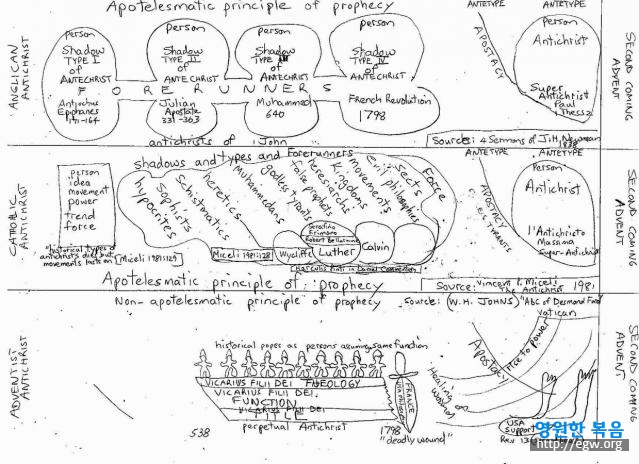Understanding vicarius filii dei (Part 4) Anglicanism, Catholicism and Adventism compared on the Antichrist
koot van wyk (DLitt et Phil; ThD)
Visiting Professor
Kyungpook National University
Sangju Campus
South Korea
Conjoint lecturer of Avondale College
Australia
19 June 2011
It was W. H. Johns who wrote an article and online G. W. Read used that information in his article on "ABC’s of Desmond Ford’s Theology" (BRI site) spelling out the concept of Ford of the apotelesmatic principle, as explained by W. H. Johns. In Ford's dissertation (1972) he did not use this principle since he operated with Preterism. Later in his Daniel Commentary (1978) he applied this principle as an attempt to fuse his preterism and historicism, and thus the hybrid is multiple fulfillments for a single prophecy. Based of course on Mark 13, Luke 21 and Matthew 24, except he missed that these three texts are not a single prophetic utterance but based on different verses in Daniel 9:26-27 and thus different time periods and different events. But what strikes us in the following comparison between Anglicanism, Catholicism and Adventism on the Antichrist, is that both J. H. Newman of Oxford 1838, and Catholic Vincent Miceli 1981 are spelling out the Antichrist concept in their denominations with the apotelesmatic principle.
The source for Anglicanism are four sermons of bishop J. H. Newman in 1838 published in 1840 on the Antichrist: "The Time of the Antichrist"; "The Religion of the Antichrist"; "The City of the Antichrist" [analyzed by him to be the city of Rome]; and lastly, "The Persecution of the Antichrist".
As can be seen in the diagram we supply, following the apotelesmatic principle of prophetic interpretation, Newman tried to fuse his concept of prophecy with using Paul and John talking about Antichrists that already at work in their day with Paul's allocation of an eschatological single person Antichrist in 1 Thessalonians 2.
Therefore he was looking for historical shadows or types of the super Antichrist to come in eschatological times, that served as forerunners to the big one in future. Antiochus Epiphanes, also singled out by apotelesmatic principle theologian in Adventism, Desmond Ford in the period 1975-1980. Especially in his Daniel Commentary this inroad is very visible. Nevertheless, Julian the Apostate emperor of 331-363 are next, Muhammed ca. 640 was the third shadow since he degraded Jesus to a mere good human and denied His divinity; and lastly the events following the French Revolution in 1798 with the wounding of the church in Rome, the pope taken prisoner by the generals of Napoleon.
As far as Newman's biblical texts are concerned and his biblical picture presented, it is almost a clear shout of Adventism, prior to historical Adventism.
Very happy with Newman's Antichrist, since Newman converted to Catholicism 7 years after preaching the sermons, Catholic Vincent Miceli in 1981 devoted a whole chapter on Newman in his book The Antichrist. This is our source for the Catholic view.
Miceli liked the idea of Newman that shadows and types were forerunners of the super Antichrist to come. I thought I saw a similar comment by Jerome in the last verses of Daniel 11:40-45, arguing against Heathen commentator Porphyry, but I have to check again? At any rate, Herculis Pinti in his Daniel Commentary of 1579 did not hesitate to use the apotelesmatic principle to apply it to the Antichrist, namely Luther and Calvin.
For Miceli the apotelesmatic principle conveniently scoop up all forces, sects, evil philosophies, movements, kingdoms, heresiarchs, false prophets, godless tyrants, muhammedans, heretics, schistmatics, sophists, hypocrites as shadows of the super antichrist to come (Miceli 1981: 128).
The Antichrist as shadow and type in history past, can be in catholic sense, operating with the apotelesmatic principle, a person, idea, movement, power, trend, force. Says Miceli that the historical types of antichrists dies but movements lasts on (Miceli 1981: 129).
That is why Wycliffe, Luther, Calvin and other reformers are all shadows and forerunners of the Antichrist to come. A preacher Serafino Frimaro called Luther the Antichrist and Robert Bellarmine agreed with him.
So far, we see that Catholics, like Anglicans, worked with a future to come super Antichrist, but until that time, any other force against religion and God are little shadows or forerunners of the super Antichrist.
Adventism are different.
For Adventism the Super Antichrist already came in 538 and persecuted for 1260 years, not days [year day principle] thus been taken hostage in 1798 or given a deadly wound by France with the help of American philosophy of liberty, freedom. For Adventism, the Antichrist is a historical person, is a human and is single acting as highest power, but the historical persons do not last longer than their lifetime. What is perpetual is the title, or function or theology of the vicarius filii dei = 666, assumed in the role of the pope as head of the Holy Roman Empire. The Antichrist is a function, theology and title assumed by an historical person to carry on or bringing continuation of the fulfillment of the Antichrist roles in this title. What is going to happen in the eschaton in Adventist views, is that the healing of the deadly wound of the first animal of Revelation 13 is going to be with the help and assistance of the second animal (USA) to such high proportions that fusion or hybrid or interaction is going to bring the actions of the expected Super Antichrist with Tribulation like there never was and persecution (see Newman also in 1838).
The apotelesmatic principle of prophetic interpretation does not operate in Adventism and was cancelled at Glazier view 1980 with the Desmond Ford saga. It is history.
Sources:
1. Vincent F. Miceli, The Antichrist (New York: Roman Catholic Books, 1981).
2. J. H. Newman, "Advent Sermons on Antichrist" Tracts for the Times vol. V (1838-1840) (London: J.G.F. & J. Rivington, 1840): 1-54.
3. G. W. Read, "The ABC’s of Desmond Ford’s Theology" (BRI article online citing the works of W. Johns.

















